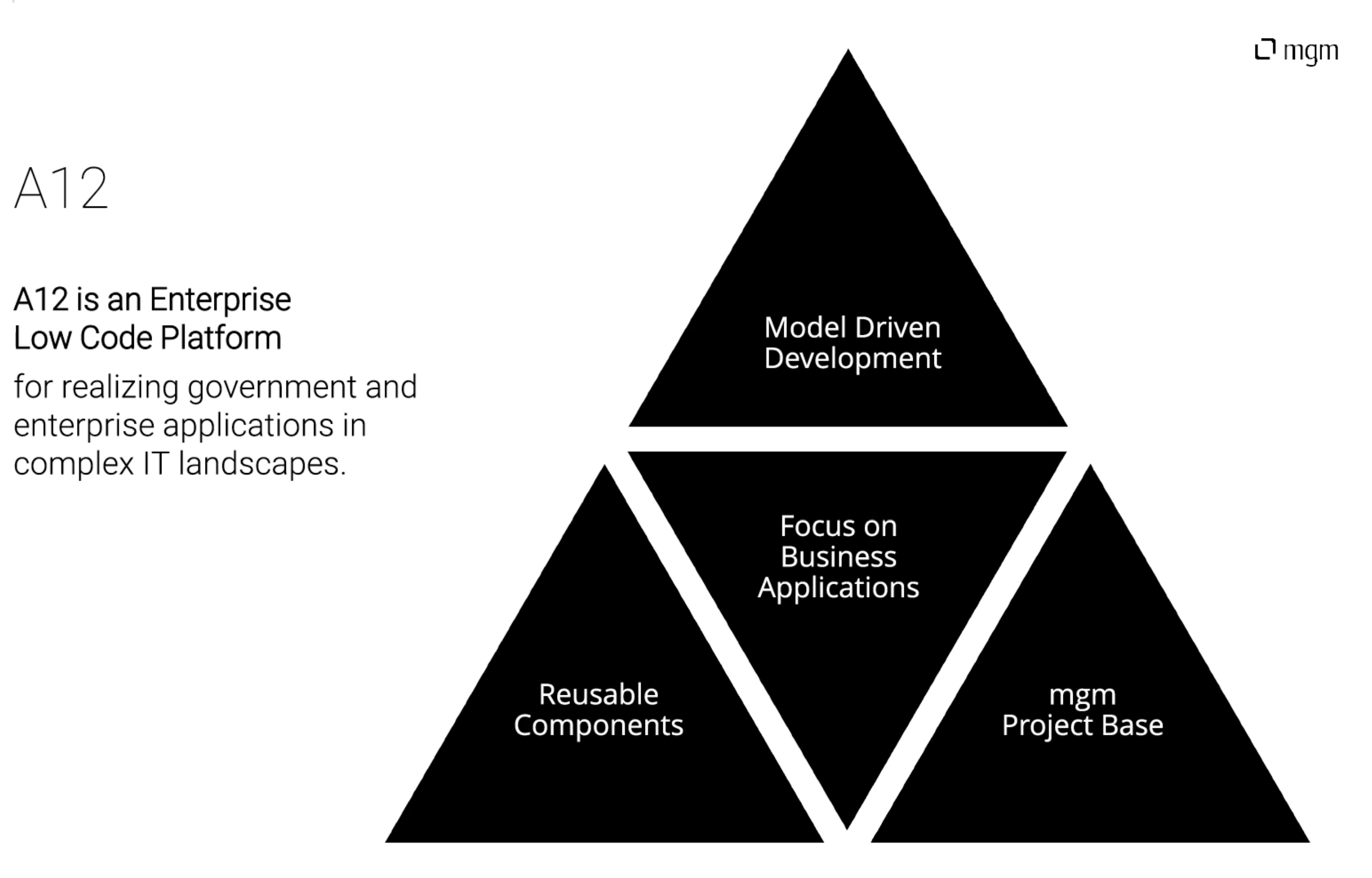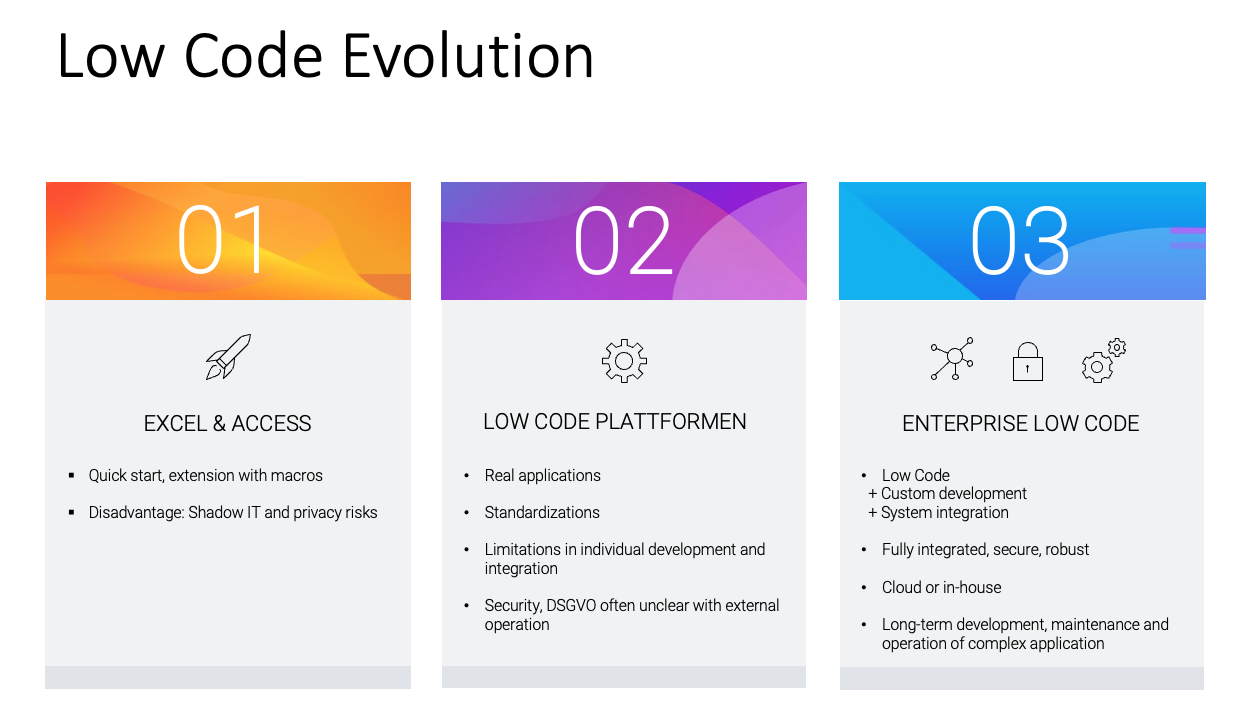Low-code development has taken the software world by storm without threatening the role of programmers. Instead, it allows developers to focus on more sophisticated aspects, especially in mission-critical applications that require custom development. The A12 Enterprise Low-Code Platform skillfully combines low-code and custom development to efficiently create tailored solutions. It is an innovative approach that is redefining software development.
Short & concise
- Low Code is a development method in which parts of the application are modeled, while the rest is custom-developed.
- While Low Code is gaining significant momentum for business applications, comprehensive Enterprise Low Code approaches are still relatively rare.
- Enterprise Low Code provides effective solutions for the issue of so-called shadow IT, denoting an application platform that enables rapid development and deployment of customized applications by abstracting or minimizing the programming code.
- At its core, the mgm A12 Enterprise Low Code platform combines a Low Code approach with professional custom software development and seamless system integration.
- In the context of the mgm A12 Enterprise Low Code platform, Low Code does not signify the end of the programmer.
The term “low code” or “low code platform” was coined by the research firm Forrester in 2014. Low code refers to various approaches rooted in model-based software engineering (MBSE). The common goal of these approaches is to create software with less manually written code. Some of the code is automatically generated or interpreted at run time after being modeled in a formalized language. The primary goal is to speed up the software development process, increase efficiency, and enable domain experts or business analysts to independently map the functional aspects of the application.
Low code is a development method that should not be confused with CRUD or no code methods. CRUD applications allow basic persistence operations to be defined through graphical user interfaces. No code, on the other hand, focuses on developing complete applications without programming knowledge. In the case of Low Code, a hybrid approach is used: parts of the application are modeled, while the rest is custom-programmed.
Low code on the rise
According to Gartner, an estimated three-quarters of all new applications will be built using low code by 2026. This approach will not be limited to application development in the next five years, but will also drive the integration of business processes, task and case management, and additional services such as Robotic Process Automation (RPA) and Artificial Intelligence (AI).
A study conducted by techconsult GmbH (link only German) in collaboration with mgm technology partners and other low-code platform providers confirms the importance of low-code development for enterprises. A survey of 253 companies highlighted the benefits (mentions as “very relevant” and “relevant”, multiple selections possible):
Advantages of No-Code / Low-Code Development – Top 10
- High application flexibility and scalability = 70%
- Improved efficiency = 68%
- Process standardization = 68%
- Cost reduction = 66%
- Increased digital skills = 66%
- IT relief = 66%
- Shorter release cycles = 64%
- High degree of automation = 64%
- Simplification = 64%
- Longevity and cost certainty = 64%
However, holistic enterprise low-code approaches are still relatively rare in practice. Some providers offer closed ecosystems where users can build and publish simple applications. This enables rapid results without significant effort or prior knowledge. However, such systems often have limitations in complex enterprise environments. In contrast, A12, the low-code approach of mgm technology partners, is an open platform suitable for enterprise use. As an open system, it offers maximum development flexibility and supports the long-term maintenance and evolution of software. The consistent separation of domain knowledge and technology also allows core business expertise to be maintained while adapting to technological advances.
Enterprise Low Code as a Business Platform: More Than Just an Excel Replacement
Enterprises often rely on pragmatic departmental solutions, resulting in what’s known as shadow IT. This includes complex Excel spreadsheets with macros, as well as simple low-code micro-applications developed without integration with enterprise IT, often without IT’s knowledge or consent. As a result, there are significant privacy and security risks that organizations must take seriously to protect their data and systems.
Enterprise Low Code provides an effective solution to the problem of shadow IT. In this approach, IT centrally deploys low-code tools, allowing businesses to maintain control over technology, standards and security. Business units can work closely with IT experts and operations to take ownership of business applications while ensuring compliance with corporate policies.
What is Enterprise Low Code?
Enterprise Low Code refers to an application platform that enables rapid development and deployment of custom applications by abstracting or minimizing the need for programming code. According to Gartner, such a platform must provide: an easy-to-use low-code development environment that enables the creation of complete applications; support for developing applications that include user interfaces, business logic, workflows, and data services; and simplified testing, deployment, and application management.
Sergio Lerena, a member of the management team at mgm technology partners, explains, “If you think of the software development process as an assembly line, different stages require different levels of variability. Sometimes pre-built building blocks that can be reused as is are sufficient. In other cases, we need to parameterize the building blocks and make them configurable to provide the necessary variability. Domain-specific languages are used by subject matter experts to model business aspects”.

However, there are cases that are highly complex but do not occur on a regular basis. In these cases, a custom implementation is the most efficient and sustainable approach. Lerena continues, “We expect that critical enterprise application projects will always include components that require custom development. It’s critical that custom development has access to the domain models to enable efficient and sustainable software development.
What makes A12 different from other low-code platforms?
Interestingly, A12 existed as a model-driven architectural approach before the term “low code” became popular. However, A12 is now referred to as an “enterprise low code platform” because this term effectively conveys the core concept that software can be developed faster and more efficiently through the use of models and code generation. This in turn simplifies software customization and maintenance.
A12 is an enterprise low-code platform that takes a unique approach by cleverly combining different development options. At its core, A12 combines a low-code approach that enables domain experts to create applications without programming skills with professional custom software development and seamless system integration.
Another notable feature of A12 is the ability for A12 projects to place direct requirements on the A12 base, similar to the requirements for their own project software. In this way, projects are actively involved in the ongoing development of A12 and can significantly influence and benefit from each other. In addition, A12 is tailored to the UI/UX needs of mature business applications with the Plasma Design System. This allows for even greater customization and optimization of the user interface for demanding business requirements where high information density is essential.
Model-Based Development with the A12 Low-Code Platform
A12 separates business logic from technology by modeling business-specific aspects. This applies to the definition of data structures, user interfaces, interactions, and application-level aspects. Runtime components or code generators interpret the business models and connect the business information contained in the models to the actual technology-related implementation.
In this way, both business experts and non-technical consultants can create, test, and maintain not only specifications, but also production-ready artifacts. The business model can evolve independently of development processes and cycles.
On the other hand, the implementation can be developed technically and to some extent conceptually without affecting the business knowledge represented by the models.
Within the data models, A12 allows the definition of computation and validation logic using a domain-specific language for business experts rather than developers. This allows them to express specific parts of the business logic that are executed consistently on both the client and server.
Conclusion
Sergio Lerena concludes: “Low code in the context of the mgm A12 Enterprise Low Code Platform does not mean the end of the programmer. Instead, it allows developers to focus their skills on more complex and customized aspects of software development. In many cases, critical applications still require custom development to meet specific requirements.
Overall, Enterprise Low Code represents a significant evolution in software development, improving efficiency and fostering collaboration between business and IT. It allows developers to focus on more challenging tasks while improving an organization’s flexibility and responsiveness.
Additional resources
- Requirements Engineering for Enterprise Low Code Platforms – Role, Process, and Benefits: Link
- (only German) Study “Low-Code/No-Code Development: Enabler of Digital Transformation. Status quo and plans of Low-Code/No-Code Development Platforms in German companies (2022), by techconsult GmbH in collaboration with mgm and others: Link
- Low-Code Association e.V. – Association of active Low Code platform providers and service providers in D-A-CH: Link
- Market research company Forrester, website on Low-Code platforms: Link
- Master’s thesis “Potential Analysis in Software Development with Low-Code Platforms in the Public Administration” by Jonas Baur: Link










